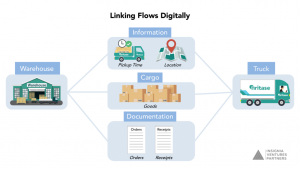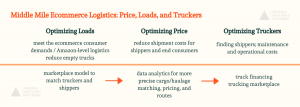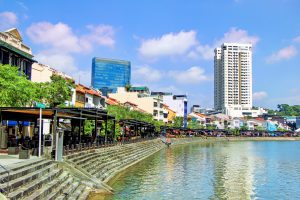Highlights
- As more ecommerce players (and their enablers) try to compete with platform giants with their own logistics stack, such as Amazon and Shopee, it is inevitable that they would rework their middle mile logistics between sorting and distribution centres to improve parcel flow. Players are starting to consolidate parcels for shipment to reduce costs, and even to better optimise haulage and route planning.
- In this fragmented market, access is poor because there is no transparency in prices. In Southeast Asia, the marketplace model does not only matches freight buyers to truckers, but seeks a fair and dynamic market price.
- To compete with Amazon, many companies are now rethinking their middle mile, adding visibility and speed from fulfilment to their final customer…[this has] also seen the rise of “Less than Truck-Load” (LTT) shipments, where smaller trucks are dispatched at a more frequent basis, to better suit ecommerce timelines.
- Where the middle mile has existed for millennia, it will continue to transform. We are seeing new technologies such as driverless trucks, and even Elon Musk’s hyperloop, which can transport cargo across countries in less than an hour instead of several days as required by train and trucking.
When I first moved to Singapore a year ago, the place that struck me the most was Boat Quay. Boat Quay is a collection of alleyways fronted with old warehouses and shopfronts: buildings that used to house the merchants and traders, facilitating trade in the region. In its heyday, Boat Quay was the embodiment of the Singaporean economy and handled the entirety of the Colony’s trade, and was the metaphorical rice bowl of its people.
In the 1980s when Singapore began transforming into a financial hub, an entirely new generation of skyscrapers sprung up right behind, providing much-needed shade to the Quay. As merchants modernised, they have gradually moved out of the now-outdated facilities, and in exchange trendy cafes and restaurants moved into the premises. Boat Quay is today still a bustling scene, with a new purpose to feed the office lunch crowd, serving as its literal rice bowl.
In our journey to enable Ecommerce Logistics in the region, we have seen the introduction of the first and last mile infrastructure over the past 5 years. These are the ecommerce logistics value chain’s skyscrapers — they are new and purpose-built additions to modernise the logistics landscape, enabling the collection and distribution of small parcels on a large-scale. On the other hand, there is a world between collection and distribution- getting parcels between different sorting and distribution centres. From aeroplanes, locomotives, to the more-common trucks in this region, the middle mile is adapting to serve the needs of the ecommerce world.
The Middle Mile is Boat Quay. The middle mile is not a new addition to our logistics landscape. Where ecommerce logistics has seen newly-designed solutions, it is also transforming the middle mile, between being ‘picked up’ and out for delivery. The demand for more frequent, and high-volume shipments has favoured scooters, tuktuks, and smaller vans. Our question now becomes — what about trucks, especially those serving long distance hauls?
Trucking: Always there for you
Whether you picked up your new Igloohome Smart Mortise 2 at a brick-and-mortar store or bought it online to have it delivered, the product still has to travel the middle mile to get to your door. Where ecommerce logistics is better known for its consumer-facing last-mile, trucking will always be in our ecosystem and continue to thrive, albeit modernised for the ecommerce world.
As more ecommerce players (and their enablers) try to compete with platform giants with their own logistics stack, such as Amazon and Shopee, it is inevitable that they would rework their middle mile logistics between sorting and distribution centres to improve parcel flow. Players are starting to consolidate parcels for shipment to reduce costs, and even to better optimise haulage and route planning.
Reducing Costs, Opening Access
In most developing countries, the logistics cost as a percentage of GDP is in its single digits. Singapore reports 8%, alongside Canada, Finland, and Germany. This is a stark contrast to Indonesia (27%), Vietnam (25%), and Thailand (20%). These little margins represent the transactional costs of economic activity and trade, rising with the presence of legacy infrastructure, capability, and reliability. The biggest attributor to this is invariably the middle-mile, which all shipments (ecommerce or otherwise), must go through.
In Southeast Asia, the middle-mile transportation of shipments largely takes place through trucks. And the region’s trucking industry is still highly fragmented. Instead of having to compare prices across different trucking companies, most trucks are owned by the drivers themselves, or otherwise by companies with less than 10 trucks. This generates a problem where SMEs have limited access to middle-mile solutions, needless to say online-only companies. If a sorting centre needs a truck to forward a stack of parcels across the country, they would normally have to call multiple trucking companies for quotes. Smaller SMEs would have to use brokers, who charge even higher fees as middlemen. It would take hours of calls and consolidating prices before a truck is found. In this fragmented market, access is poor because there is no transparency in prices.
In this fragmented market, access is poor because there is no transparency in prices.
In Southeast Asia, we have seen companies like LOGIVAN (Vietnam) and Ritase (Indonesia) helping companies reduce transportation costs and increase transparency with a marketplace model, which not only matches freight buyers to truckers, but seeks a fair and dynamic market price. The marketplace model solves a cost factor in the trucking scene — empty backhauls, where due to poor planning, 90% of delivery trucks return empty resulting in clients having to pay double to cover the empty return journey. On a macro-level, this also causes huge congestion on intercity roadways and large pollution to the countryside.
Optimising Haulage- not all trucks are the same!
To say Amazon is hyper-efficient is an understatement: to the public eye, they have their own last-mile delivery systems with the ‘Amazon deliveryman’ now a fitting mascot for the company. On the other hand, we have seen their now-famous fulfilment centres of pickers and packers, silently being served by large trucks plying from fulfilment centres to sorting facilities, completing the middle mile.
What if we’re not Amazon but still want that ‘Amazon-level’ logistics? To compete with Amazon, many companies are now rethinking their middle mile, adding visibility and speed from fulfilment to their final customer. This has not only seen greater consolidation of shipments, where fulfilment and distribution centres serve to consolidate ecommerce parcels in a truckload, but also seen the rise of “Less than Truck-Load” (LTT) shipments, where smaller trucks are dispatched at a more frequent basis, to better suit ecommerce timelines.
To compete with Amazon, many companies are now rethinking their middle mile, adding visibility and speed from fulfilment to their final customer…[this has] also seen the rise of “Less than Truck-Load” (LTT) shipments, where smaller trucks are dispatched at a more frequent basis, to better suit ecommerce timelines.
LOGIVAN‘s marketplace model connects 20 thousand transportation partners with all major truck types, both big and small across routes traversing northern and southern provinces in Vietnam. The company’s top value proposition is now not only enabling SME shippers to connect to truckers, but also help them find a suitable truck size. For the ecommerce side of the house, this makes ecommerce dispatchments between distribution and sorting centres much more efficient and economical. With a central marketplace, LOGIVAN has also now invested in data analytics and cross-platform integration to improve supply chain visibility and reduce lead times.

A snapshot of the middle-mile value chain, taken from Ritase CEO’s interview with Insignia Business Review
We see the same in Indonesia where even the larger companies such as the FMCG giants are working to improve their middle mile logistics for both visibility and speed. 90% of middle mile delays occur due to incorrect documentation or wrong information, such as pickup timing and locations, making for long transit times. FMCGs like Unilever and Nestle both use the same enterprise software but manage their supply chains very differently, with different SOPs to manage products from pick-up to last-mile drop-off. Companies like Ritase therefore not only help with cargo matching and liberating the trucking industry via a marketplace model, but also ensures that the shipment is free from delays.
Final Thoughts
As I write this piece at a Boat Quay café, I notice that many of the once-hip restaurants have shuttered due to the coronavirus. The office crowd is no longer present, now working from home, and even restaurants are being disrupted by their cloud counterparts. It would be anybody’s guess what Boat Quay may transform into next.
Similarly, where the middle mile has existed for millennia, it will continue to transform. We are seeing new technologies such as driverless trucks, and even Elon Musk’s hyperloop, which can transport cargo across countries in less than an hour instead of several days as required by train and trucking. Insignia is on the lookout for unstoppable players in the middle-mile space- ping us if you’re building something exciting!
Russell is excited about the power of innovation improving lives across Southeast Asia. An ex-founder from the London McKinsey Venture Academy, Russell is now looking for daring new founders in Southeast Asia. Drop your pitch at russell@insignia.vc.


